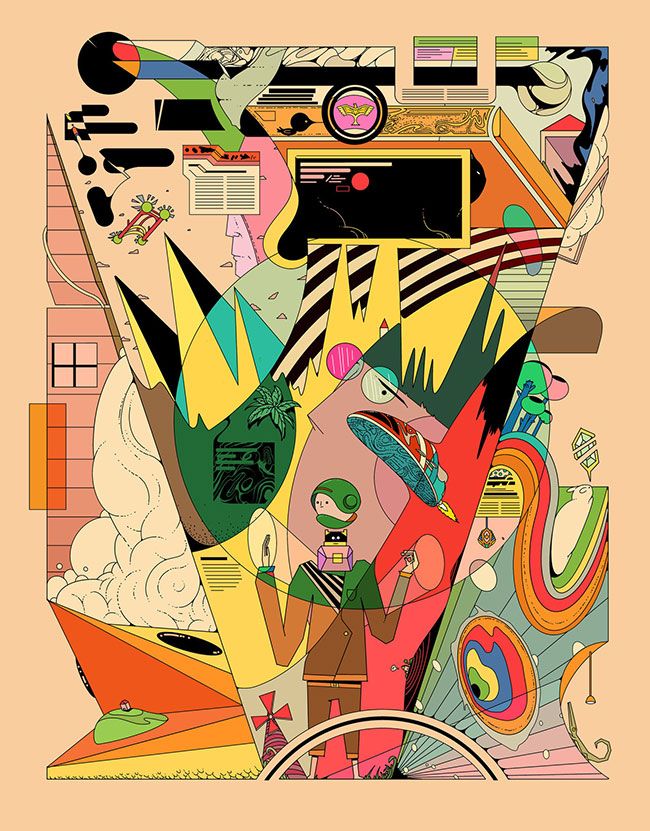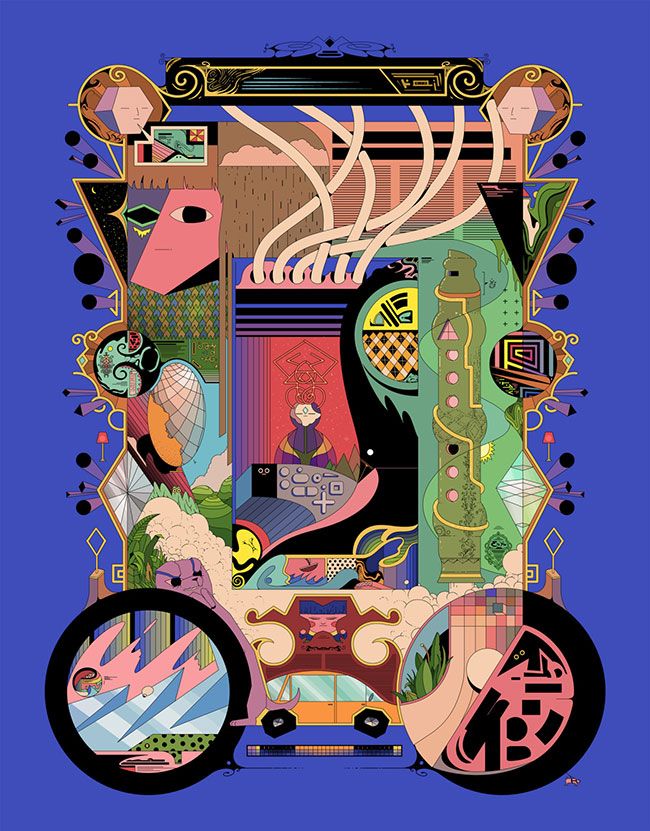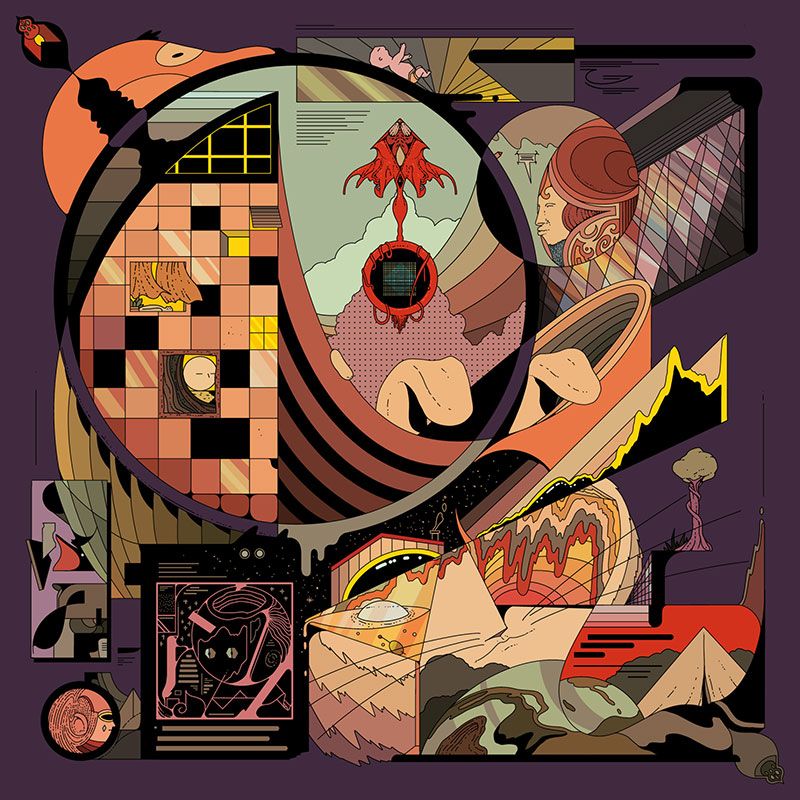{english below} Algunas veces puede verse la naturaleza liquida de una obra. Su fluidez. Como los objetos siguen moviéndose, flotando. Y no tiene por que ser una razón de vitalidad. De percibirlos reales y vivos. Sino de movimiento, de cómo conectan y giran agitándose levemente desde la cabeza inconsciente del autor a la cabeza inconsciente del espectador. Puede ser una empatía estética colectiva (o puede que no), pero la prueba está en las obras. Al igual que su misterio y, más importante aún, su sorpresa. La obra de Ori Toor radica en esa sorpresa. En sorprenderse a sí mismo, desde las raíces mismas del proceso. En este juego ya hay genialidad.
En Staf Magazine tenemos el placer de charlar con él y contar con su imaginación en la portada que ha realizado para este especial de fotografía, disfrútenla.

¿Qué recuerdas de tu infancia y que te atrajera tanto hacia las artes? ¿Cuales fueron tus principales influencias de juventud y luego de madurez? ¿Cómo fue tu formación profesional y lo que consideras tú como formación personal para tus propios intereses artísticos?
Crecí en una fábrica de alfombras donde mi madre trabajaba como diseñadora principal. Recuerdo lo impresionante que fue ver las creaciones de mi madre convertidas de pequeños dibujos de acuarela en grandes lienzos. Solía jugar en la cima de montañas de alfombras enrolladas mirando el proceso de la lana que literalmente era disparada al lienzo por grandes máquinas naranjas. Pero lo que realmente me interesó fue la animación. Vi muchos Road Runner y Looney Tunes y también vi un documental sobre el proceso de animación (con los saltos entre páginas) y me impresionó tanto la velocidad que puede crear un personaje de aspecto genial. Al crecer, mi entrenamiento fue principalmente dibujar a Taz una y otra vez (no muy bien). El diseño de sus ojos realmente me abrió la mente a todas las posibilidades.
Te criaste y vives en Tel-Aviv. Hablanos por favor de la escena artística independiente de Israel y tu experiencia personal en ella mientras te hacías profesional.
Nunca falta la inspiración local en Tel Aviv (en realidad, todo Israel. Es un país pequeño). Mientras estudiaba ilustración en la universidad había muchos artistas callejeros (por ejemplo: Klone, Broken Fingaz, Know Hope) e ilustradores (demasiados para siquiera empezar) a admirar. Cuando miro la escena hoy, especialmente ilustradores, es sorprendente la cantidad de talento que surge cada año. Pienso que hay una considerable exportación de autores israelíes que la mayoría de la gente desconoce. Es muy difícil para los ilustradores ganarse la vida aquí, por lo que todo este talento desaparece o se está utilizando en todo el mundo.

¿Cuales son tus técnicas de trabajo habituales y cómo llegaste a ellas en tu propio desarrollo artístico? ¿Te planteas actualmente otras técnicas de trabajo?
La única constante en mi proceso que nunca cambia es la improvisación. Aprendí una lección personal que seguirá siendo verdad para mí durante toda la vida: cuanto más pienso y planifico, peor es mi arte.
Me encanta experimentar y observar diferentes técnicas. Siempre trato de usar diferentes herramientas o trato de aprender 3d. Pero nunca dejaré de improvisar. Mis errores siempre son mejores que mis planes.
Tu trabajo se caracteriza por la mezcla, tanto de formas como de colores, y que improvisas y te dejas llevar un montón. ¿Te sorprendes a ti mismo encontrando formas o significados en cierto modo, inconscientes? ¿Qué sensaciones y estímulos te produce ir “descubriéndote” mientras trabajas?
Si no estoy sorprendido, entonces algo está mal. Realmente me gusta ver cómo las cosas toman forma y crecen.
El proceso real es como mirar nubes y encontrar objetos y personajes.
Cuando se hace una pieza, hay una fase en la que miro todo y empiezo a pensar en lo que estoy viendo. Me gusta “¿qué quise decir con esto?”.

Tu trabajo tiene fuertes conceptos surrealistas y abstractos. ¿Qué piensas de las ideas básicas y fundacionales de estas corrientes artísticas y de su evolución y aplicación en el arte y la cultura actual?
El cerebro es un dispositivo que capta la realidad y produce una narración que tiene sentido para sí mismo. Es por eso que la humanidad está tan obsesionada con la narración de cuentos. Las expresiones surrealistas y abstractas del arte están quizás más cerca de la actividad cerebral inconsciente y automática. Es una manera de compartir las corrientes profundas de bajo nivel de nuestras mentes entre nosotros. Cuando miras las tendencias, es como ver que todos los cerebros se sincronizan con una idea. Reaccionando al Zeitgeist.
Básicamente, todos estamos de acuerdo por el momento en que estamos condenados.

Trabajas tanto para ti mismo como para grandes marcas como Nike, Cartoon Networks, Apple o Samsung. Teniendo un estilo tan personal y propio como el tuyo, ¿qué diferencias encuentras entre trabajar para otros y tus propios proyectos?
Realmente me encantaría pensar que no hay diferencia. Quiero decir, hacia eso me esfuerzo.
Por supuesto que hay una diferencia. Incluso cuando un cliente me da libertad absoluta (y la mayoría lo hace), siempre me siento más libre trabajando en mis propias cosas, pero tener restricciones de clientes no es necesariamente algo malo. Me encanta analizar un tema o incorporar elementos que el cliente me pide que use. A menudo puede ayudarme y empujarme hacia adelante.
Es un equilibrio delicado. Si hago demasiado de uno, el otro sufre. En este momento estoy tratando de volver a hacer más trabajo personal después de un año ocupado con proyectos profesionales.
También has trabajado ocasionalmente en videos musicales, ¿qué puedes contarnos sobre ello?
Durante años estuve seguro de que solo tendría una carrera como animador. Y me encantó explorar la idea de la improvisación en la animación. Los últimos años se han centrado más en la ilustración y no veo que cambie pronto, pero nunca digas nunca.

Siempre estas explorando, tanto nuevas técnicas como conceptos ¿cómo trabajas cuando encuentras nuevas ideas que te atraen?
Básicamente, entro en pánico y empiezo a trabajar frenéticamente, esperando que el nuevo concepto sea algo que valga la pena.
¿Qué piensas de la situación del arte urbano actual? Vive un apogeo cultural muy diverso que está transformando tanto el contexto académico del arte como las formas de galerías y museos, y se mantiene fuerte e imparable en su medio natural: la calle. Y es en cierto modo, más comunicativo, tanto en sus forma comercial para empresas como en las más puramente personal. Y, ¿qué futuro y desarrollo piensas también que llegará a tener?
Estoy vergonzosamente desconectado de la escena artística, de verdad. Solía ser lo contrario, pero me di cuenta de que en algún momento mi trabajo mejora cuanto menos al tanto estoy de los que ocurre. Realmente no tengo una buena opinión sobre el arte actual, pero estoy muy contento de que las paredes se rompan y cada vez más personas estén expuestas a las creaciones de otros.

Del panorama actual, ¿qué otros artistas te llaman la atención y qué artistas menos mediáticos nos recomendarías?
Favoritos actuales:
www.instagram.com/southersalazar
www.instagram.com/harrybhal
www.instagram.com/gastonpacheco_art
instagram.com/danielhshaffer
instagram.com/laurierowan
instagram.com/boldtron
www.instagram.com/feliciachiao
instagram.com/shintarokago1969
www.instagram.com/jonboam
instagram.com/grand_chamaco
www.instagram.com/zuttoworld

¿Qué otros medios artísticos fuera de la ilustración dirías que son una importante influencia en tus ideas y tu trabajo?
Videojuegos, especialmente nintendo. Aburridos objetos cotidianos como teléfonos, tazas, plantas, zapatos, lámparas y más. Arquitectura. Jazz africano. Perros.
¿Qué puedes comentarnos sobre tus futuros proyectos?
Totalmente despistado sobre lo que vendrá después. Pero, de nuevo, me gustan las sorpresas agradables.










English:
ORI TOOR. CREATE THE SURPRISE
Sometimes you can see the liquid nature of a work. Your fluency As objects keep moving, floating. And it doesn’t have to be a vitality reason. To perceive them real and alive. But of movement, of how they connect and turn shaking slightly from the author’s unconscious head to the viewer’s unconscious head. It may be a collective aesthetic empathy (or maybe not), but the proof is in the works. Like his mystery and, more importantly, his surprise. Ori Toor’s work lies in that surprise. In surprising himself, from the very roots of the process. In this game there is already genius.
In Staf Magazine we have the pleasure of chatting with him and having his imagination on the cover he has made for this photography special, enjoy it.
What do you remember about your childhood and what attracted you so much to the arts? What were your main influences of youth and then of maturity? How was your professional training and what do you consider as personal training for your own artistic interests?
I grew up at a carpet factory where my mom worked as head designer. I remember how impressive it was seeing my mom’s creations converted from small watercolor drawings into huge canvases. I used to play on top of mountains of rolled up carpets watching the process of wool being literally shot into the canvas by big orange gun-like machines. But what really interested me back than was animation. I watched a lot of Road Runner and Looney Tunes and I also saw some documentary about the process of animation (with the page flipping) and was so impressed by the speed you can create a cool looking character. Growing up my training was mostly drawing Taz over and over again (not very well). The design of his eyes really opened my mind to the possibilities.
You grew up and live in Tel-Aviv. Please tell us about Israel’s independent art scene and your personal experience in it while you became professional.
There is never a lack of local inspiration in Tel Aviv (All of Israel actually. It’s a tiny country). While studying illustration in college There were lots of street artists (ex: Klone, Broken Fingaz, Know Hope) and illustrators (too many to even start) to admire. When I look at the scene today, especially illustrators – It’s amazing how much talent is added each year. I think it’s a major Israeli export most people aren’t aware of. It’s very difficult of illustrators to make a living here so all of this talent either disappears or is being utilized around the world.
What are your usual work techniques and how did you get there in your own artistic development? Do you currently consider other work techniques?
The one constant in my process that never changes is improvisation. I learned a personal lesson that I keep being true for me throughout life: The more I think and plan – The worst my art gets.
I love experimenting and looking at different techniques. I always try using different tools or try to learn 3d. But I’ll never stop improvising. My mistakes are always better than my plans.
Your work is characterized by mixing, both shapes and colors, and you improvise and let yourself be carried away a lot. Do you surprise yourself by finding unconscious ways or meanings in a way? What sensations and stimuli do you go “discovering” while working?
If I’m not surprised then something is wrong. I really like seeing how things take shape and grow.
The actual process is kind of like looking at clouds and finding objects and characters.
When A piece is done there’s this phase when I look at everything and start thinking about what I’m seeing. I’m like “what did I mean by this?”.
Your work has strong surreal and abstract concepts. What do you think of the basic and foundational ideas of these artistic trends and their evolution and application in current art and culture?
The brain is a device that takes in reality and produces a narrative that makes sense to itself. It’s why humanity is so obsessed with storytelling. Surreal and abstract expressions of art are maybe closer to the unconscious and automatic brain activity. It’s a way to share the deep low level currents of our minds with each other. When you look at the trends it’s like seeing all of the brains sync up to an idea. Reacting to the Zeitgeist.
So basically, we all agree we’re doomed at the moment.
You work for yourself as well as for big brands like Nike, Cartoon Networks, Apple or Samsung. Having a personal and personal style like yours, what differences do you find between working for others and your own projects?
I would really love to think there’s no difference. I mean, that’s what I strive towards.
Of course there is a difference. Even when a client gives me absolute freedom (and most do), I always feel more free working on my own stuff.
but having client restrictions is not necessarily a bad thing. I love riffing on a theme or incorporating elements the client asks me to use. It can often help to push me forward.
It’s a delicate balance. If I do too much of one, the other suffers. Right now I’m trying to get back to doing more personal work after a year busy with professional projects.
You have also occasionally worked on music videos, what can you tell us about it?
For years, I was certain I’ll only have a career as an animator. And I loved exploring the idea of improvisation in animation. The past few years have been more illustration focused to me and I don’t see it changing any time soon but never say never.
You are always exploring, both new techniques and concepts, how do you work when you find new ideas that appeal to you?
Basically, I panic and start working frantically, hoping that new concept is something worthwhile.
What do you think of the current urban art situation? Live a very diverse cultural heyday that is transforming both the academic context of art and the forms of galleries and museums, and remains strong and unstoppable in its natural environment: the street. And it is in a way, more communicative, both in its commercial form for companies and in the most purely personal. And what future and development do you also think it will have?
I’m embarrassingly disconnected from the art scene, really. It used to be the opposite but I realized at some point my work gets better the less I know about what’s hip at the moment. I don’t really have a hot take regarding current art but I’m really glad the walls are breaking and more and more people are exposed to the creations of others.
What other artistic means outside the illustration would you say are an important influence on your ideas and your work?
Video games, especially nintendo. Boring everyday objects like phones, cups, plants, shoes, lamps and more. Architecture. African jazz. Dogs.
What can you tell us about your future projects?
Totally clueless about what comes next. But then again, I like nice surprises.
www.oritoor.com